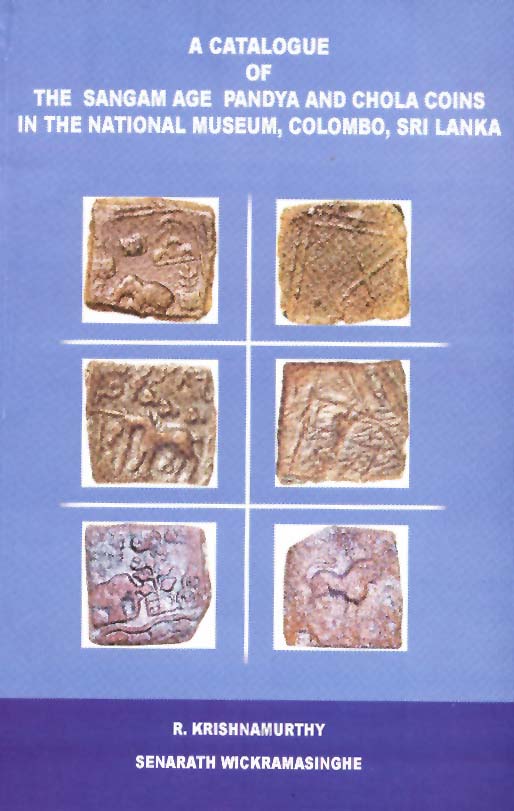A Catalogue
of
The Sangam Age Pandaya and Chola Coins
In the National Museum, Colombo, SriLanka
by Ramasubbu Krishnamurthy & Senarath Wickramasinghe
14cm x 21.6cm 40 pages of which 15 are a catalog of good quality (150dpi)
color images and line-drawings of 44 Sangam Age Coins with descriptions.
Printed on Art Paper at State Printing Corporation, Pitakotte, Sri Lanka.
First Published 2005 by Department of National Museums,
P. O. Box 854, Colombo, Sri Lanka
1000 copies - ISBN 955 - 578 = 017 - X
Rs 200/= available at the Colombo Museum Bookshop
| 
|
The Sangam Age has been associated with the period from
150 to 750 B.E. (i.e. 300 BCE to 300 CE ) in South India and
northern Lanka. Of the 73 Sangam age Tamil Coins in the Colombo
Museum Collection, 70 belong to the Hettiarachchi collection and 41
Pandya coins and 3 Chola coins in fairly good condition have been
illustrated in this new catalog. Senarath Wickramasinghe writes about
Trade Connections during the Sangam Age, including two maps,
and Krishnamurthy about the Sangam Age coins in the National
Museum, Colombo, both with references and Notes. Ramasubbu
Krishnamurthy's 1997 book Sangam Age Tamil Coins is a classic
south Asian numismatic book of the era.
Codrington call these coins "Buddhist Cakram", and I found it
interesting that the Sangam age derives its name from the earliest
strata of Tamil literature to the last (Kandai) Sangam "probably
modeled on the Buddhist Sanga for the promotion of Tamil
literature" at Madurai in Tamilnadu. The region known as
"Tamilaham" was ruled by three major dynasties known as Chera, Chola
and Pandya.
These almost square copper coins vary in size from 13 MM to 28 MM and
weigh from under 1 gram to over 11 grams, a large range of weights and
sizes as in modern coinage. Krishnamurthy states that these coins
kept in paper pouches were never taken out and examined. The
Pandaya coins have a stylised fish symbol on the obverse, while the
Chola coins have a tiger which looks almost like the lion in the
modern Sri Lankan Flag. Chera coins which would have had a bow and he
comments that it is unexplained why there were none in this
collection.
The reverse of most of the coins have multiple symbols.
An elephant standing to left or right. A few have a horse or a bull instead.
Other symbols such as
the Bo-tree in railing, the three arched hill which are also seen on
Lankan coins of the same era. None of the coins have the
railed-swastika which was the symbol of the Lankan monarchy. Of
particular interest is coins numbered 4 and 5 which have been over
struck with a circular counter-stamp with the tree-in-railing
symbol. Raja Wickremasingha, president of the Sri Lanka Numismatic
society recently presented a paper on a coin like this, he thought was
unique. Coin numbered 17 is also interesting since it shows the king
with a crown seated on an elephant. A triangular symbol very similar
to the Ankh the Egyptian symbol of life is drawn above.
The format of the new catalog is nice. The color image, line drawing
and detailed descriptions of every coin is on the same page for easy
reference. Many numismatic books put the images in plates at the end
or separate the color images from the line drawing, or the
descriptions sometimes break in to two pages. I am glad the publishes
have carefully ensured that reference is not cumbersome. However they
have omitted the scale. In an attempt to display in a fixed size
frame, some coins are displayed at actual size, while some are
significantly enlarged and some reduced in size. The scale can be
roughly computed from the dimensions given, but that is not
convenient.
In the forward to this book Dr Nanda Wickramasinghe, Director of the
Department of National Museums in Sri Lanka, states and I quote
Dissemination of material information on museum collections and its
publication is one of the major responsibilities of a museum. She
also states that since their last numismatic publication in English,
the classic
Ceylon Coins and Currency in H. W. Codrington, the collection
has increased three fold to 85,000 coins.
I hope that this book is just the first of a new series of books on
coins in the Colombo Museum. I understand one is now been prepared on
Lakshmi Plaques. I recommend that these books are also put on-line
since one can overcome the printing limitation and display the coins
in high resolution needed for detailed study the fascinating
iconography.
It was very refreshing to find a new book on coins published by Museum
in their bookshop when I visited it a few days ago. I am amazed that
no publicity has been given to this new publication, which is
a good buy at an affordable cost, for anyone interested in coins or
iconography.
This review by Dr Kavan Ratnatunga
is hosted by coins.lakdiva.org.lk.
a website for Coins of Lanka.
An edited version of this review
Coins of many shapes and symbols of the Sangam Age By Kavan Ratnatunga appeared in the
SundayTimes of Sri Lanka on 2006 March 5th
